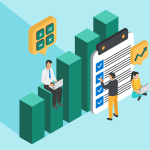AI Agents: The Future of Business Applications

AI agents are set to become ubiquitous in our daily lives. Here's how they work and how they are transforming business and application development alike.
Agents are assistive and autonomous software systems. Based on user input or environmental conditions, they reason, plan, and take action to achieve a given task or goal. They are like intelligent digital assistants, equipped with the aggregated knowledge and experience of human experts, and access to all relevant data.
Agents are set to become ubiquitous across every area of our lives, and to profoundly transform how businesses operate and interact with customers. For example, a service agent can act as your company’s most knowledgeable technical support representative, available 24/7 to handle every request.
A marketing agent, much like a self-driving car, can use “sensors” (real-time data) to detect changing business conditions and respond proactively (adjust pricing, launch a campaign, and so on).
This article covers the AI innovations driving the emergence of agents, and explores how agents are not only transforming businesses but also reshaping software and software development.
Powered by large language models
AI agents are made possible through the emergence of large language models (LLMs). LLMs provide two essential capabilities required to implement highly effective agents:
- Deep language understanding: LLMs are great at understanding complex and nuanced language. This is a crucial capability for chatbot-type agents, allowing them to understand a user request at a deep level and formulate responses using natural language.
- Reasoning and decision-making: LLMs can also reason and make decisions. This enables agents to build a plan and orchestrate the steps required to solve the problem at hand.
But LLMs alone are not sufficient to implement agents. They have a number of limitations, including:
- Lack of access to private data: LLMs don’t have access to private data they were not trained on. For example, they can’t return a list of open sales opportunities, open support tickets, or campaign results to date.
- No built-in ability to take action: For example, they can’t open a support ticket, change the shipping address of an order, update an opportunity record, or change the price of a product.
A new software paradigm
Agents bridge the gap between the powerful language and reasoning capabilities of LLMs and the practical demands of business use cases, such as private data access and action execution, paving the way for a new software paradigm.
Software is no longer built as full-fledged applications but as a collection of granular building blocks that encapsulate specific capabilities and that can be orchestrated by agents using the LLM’s reasoning capabilities. At Salesforce, these building blocks are referred to as actions (for example, “Locate Order” and “Change Order Address”) and are organised under functional areas called topics (for example, “Order Management”).
In other words, an agent is a software system that uses an LLM’s language and reasoning abilities to orchestrate a collection of actions within a specific domain. At a high level, an agent works as follows:
- Understand the task: The agent uses the LLM’s language capabilities to gain a deep understanding of the task at hand.
- Iteratively plan and execute: Based on its understanding of the task, the agent reasons on available actions and identifies what to do next. This can include executing actions or asking clarifying questions. The agent then reasons on the outcome of the previous step and again identifies what to do next. The agent repeats that iterative process until it is satisfied it has addressed the original task.
- Provide response: The agent produces the response to the input.
The ultimate application composition platform
The most transformative aspect of this new software paradigm is that it enables agents to handle unanticipated requests without predefined requirements. Imagine an agent equipped with dozens or even hundreds of actions. It could compose them in a virtually infinite number of ways, including in ways never anticipated, enabling it to solve new problems on the fly. This is the ultimate form of application composition.
For example, at Salesforce, our industry-leading applications (including Sales Cloud, Service Cloud, Marketing Cloud, Commerce Cloud, and Industries) are broken down into granular actions that can instantly enable Salesforce’s Agentforce Agents with a wealth of capabilities across various topics.
Agentforce Agents can compose and orchestrate these actions in any number of ways, providing users with a seamless and unified experience across the business. In addition, developers can extend the standard Agentforce Agents’ capabilities with custom actions powered by code, APIs, Salesforce flows, or prompt templates.
Actions empower agents with the following essential capabilities:
- Access to private company data: Actions provide agents with access to your customer and enterprise data. When giving any agent access to data, it’s important to ensure that the agent doesn’t disclose data to unauthorised users. Using Agentforce Agents, access to data is governed by permissions and sharing models. The same permissions and sharing models apply regardless of where the data is accessed from: traditional applications or agents.
- Ability to take action: Actions enable agents to execute logic and integrate with external systems. Standard Agentforce actions have that ability built-in: They can act on sales, service, marketing, commerce, and industries. In addition, developers can build custom actions that can act on Salesforce or external systems using code, APIs, flows, and prompt templates.
Different levels of autonomy
Agents can have different levels of autonomy. For example:
- Assistive agents (sometimes referred to as copilots) collaborate with humans, enhancing capabilities rather than acting alone. Copilots often require human input and feedback to refine suggestions or actions.
- Autonomous agents operate independently without direct human supervision. Agentforce Agents, unlike other autonomous agents, have the capability to seamlessly hand off tasks to humans as needed.
Regardless of an agent’s autonomy level, establishing appropriate guardrails is crucial to ensure reliability, adherence to business practices, and data security and privacy, as well as to prevent hallucinations, toxicity, and harmful content.
Agentforce Agents use a multilayered approach to enforce guardrails:
- Einstein Trust Layer: The Einstein Trust Layer enables agents to use LLMs in a trusted way, without compromising company data. It uses a secure gateway, data masking, toxicity detection, audit trails, and more to control LLM interactions.
- Instructions: When defining an Agentforce Agent, you can use natural language to provide clear instructions, including what to do and what to avoid, effectively setting the guardrails for its behaviour.
- Shared metadata: Salesforce metadata defines overarching rules that are enforced regardless of whether the data is accessed from traditional applications or agents. This includes permissions, sharing models, validation rules, and workflow automation to guarantee data security and adherence to business practices.
- Agent Analytics: This observability tool provides insights into agent and action performance, usability, and reliability, enabling you to identify areas for improvement.
- AI Test Centre: A unified testing framework, the AI Test Centre supports batch testing for agents, prompt templates, retrieval-augmented generation (RAG), and model use cases.
Ready-to-use agents for sales and service
Salesforce recently announced agents for Sales and Service:
- Agentforce Service Agent revolutionises customer service with its ability to understand and take action on a broad range of service issues without preprogrammed scenarios, helping make customer service far more efficient.
- Agentforce SDR Agent autonomously engages with inbound leads, in natural language, to answer questions, handle objections, and book meetings for human sellers.
- Agentforce Sales Coach Agent autonomously engages in role-plays with sellers, simulating a buyer during discovery, pitch, or negotiation calls.
You can use these agents out-of-the box, but Agentforce also enables you to customise them, extend them, and create your own agents.
Create and Customise Agents with Agentforce
Salesforce Agentforce brings humans together with autonomous agents powered by AI, data, and action. It provides the features and tools you need to create, customise, and deploy trusted agents and other innovative AI applications, complete with the right guardrails and supervision. Let’s take a closer look and walk through the key components.

Diagram: The Salesforce Platform components for building agents and AI applications
Metadata
Salesforce metadata establishes universal rules that are enforced regardless of whether the data is accessed from traditional applications or agents. This includes permissions, sharing models, validation rules, and workflow automation to ensure data security and adherence to business practices.
Metadata also allows LLMs to better understand the context and meaning of the data, which can lead to more accurate responses. For example, an LLM could use metadata to present CRM data to the user in a more useful and actionable way (ad hoc UI).
Data Cloud
To get good AI you need high-quality and unified data. Salesforce Data Cloud brings together and unifies all your data — Salesforce and external, structured and unstructured — to ground AI with high-quality, relevant, and actionable information. With over 200 available connectors and the ability to easily create custom ones, Data Cloud provides unparalleled connectivity.
Once your data is connected, unified, and harmonised, Data Cloud enables you to activate it at scale in AI agents, analytics, and other applications, delivering valuable insights and personalised experiences. The days of siloed experiences limited by siloed data are over. Users, whether they are employees or customers, expect connected experiences that bring together and make sense of all relevant data.
Models
Agentforce provides a configurable model architecture that enables you to easily plug in and compose models. A hosted foundation model often provides you with the fastest path to AI innovation, but you can also use fine-tuned models or your own models built with your own data.
Einstein Trust Layer
The Einstein Trust Layer lets you use existing models in a trusted way, without compromising your company data. Here’s how it works:
- Secure gateway: Agentforce accesses models through a secure gateway that enforces security and privacy policies consistently across different model providers.
- Data masking and compliance: Before the request is sent to the model provider, it goes through a number of steps including data masking, which replaces personally identifiable information (PII) data with anonymised data to ensure data privacy and compliance.
- Zero retention: To further protect your data, Salesforce has zero-retention agreements with model providers, which means providers will not persist or further train their models with data sent from Salesforce.
- Demasking, toxicity detection, and audit trail: When the output is received from the model, it goes through another series of steps, including demasking, toxicity detection, and audit trail logging. Demasking restores the real data that was replaced by fake data for privacy. Toxicity detection checks for any harmful or offensive content in the output. Audit trail logging records the entire process for auditing purposes.
Actions
Actions provide agents with the ability to execute logic and integrate with external systems. Standard Agentforce actions can act on sales, service, marketing, commerce, and industries. In addition, developers can build custom actions that can act on Salesforce or external systems using custom code, APIs, flows, and prompt templates.
Topics
A topic is a logical grouping of actions representing a specific area of focus that an agent is designed to understand, process, or respond to. Examples include order management, warranty, pricing, FAQ, and so on.
Agents
Agentforce Agents are autonomous software systems that can analyse user or environmental inputs, identify tasks, reason through solutions, and orchestrate actions to complete them. Agents have different levels of autonomy. Assistive (partially autonomous) agents collaborate with humans to perform the task at hand. Autonomous agents operate independently without direct human supervision but with the robust guardrails described earlier in this post, and the ability to hand off tasks to humans as needed.
Tooling
Agentforce provides a variety of low-code tools to build agents and other AI applications.
Prompt Builder is a Salesforce builder that enables you to create reusable prompt templates in a graphical environment, and ground them with dynamic data made available through record page data, Data Cloud, API calls, flows, and Apex.
Agent Builder is another visual builder that enables you to configure agents and copilots. You can select the actions available to your agent and try out your agent in a playground environment.

Caption: A screenshot of Salesforce Agent Builder
Model Builder allows you to build or bring your own AI models.
Summary: How Agentforce Agents are transforming business and application development
Agents are set to become ubiquitous in every area of our lives. They can reason, orchestrate tasks, and take action, delivering personalised experiences at scale. By combining the language and reasoning capabilities of LLMs with software building blocks, they are transforming how businesses operate and how software is built.
Agentforce Agents are leading this transformation with key differentiating characteristics, including:
- Trusted. Agentforce protects your data using the Einstein Trust Layer and the same metadata, permissions, and sharing models as traditional Salesforce applications.
- Powerful. Agentforce Agents make use of industry-leading Salesforce applications to deliver transformative experiences across sales, service, commerce, marketing, and industries.
- Grounded in unified data. Agentforce Agents deliver more accurate and relevant outcomes by grounding AI in all the relevant data made available and unified by Data Cloud.
- Low-code tools. Agentforce Agents can be built, customised, tested, and managed using a set of low-code tools including Agent Builder, Prompt Builder, Model Builder, Flow Builder, and more.


























